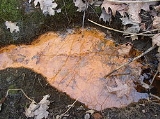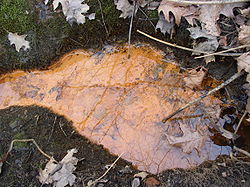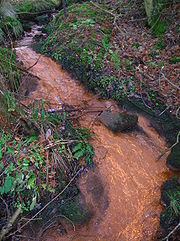
Iron bacteria
Encyclopedia

Water supply
Water supply is the provision of water by public utilities, commercial organisations, community endeavours or by individuals, usually via a system of pumps and pipes...
well
Water well
A water well is an excavation or structure created in the ground by digging, driving, boring or drilling to access groundwater in underground aquifers. The well water is drawn by an electric submersible pump, a trash pump, a vertical turbine pump, a handpump or a mechanical pump...
s, iron bacteria are bacteria
Bacteria
Bacteria are a large domain of prokaryotic microorganisms. Typically a few micrometres in length, bacteria have a wide range of shapes, ranging from spheres to rods and spirals...
that derive the energy
Energy
In physics, energy is an indirectly observed quantity. It is often understood as the ability a physical system has to do work on other physical systems...
they need to live and multiply by oxidizing dissolve
Solution
In chemistry, a solution is a homogeneous mixture composed of only one phase. In such a mixture, a solute is dissolved in another substance, known as a solvent. The solvent does the dissolving.- Types of solutions :...
d ferrous iron (or the less frequently available manganese
Manganese
Manganese is a chemical element, designated by the symbol Mn. It has the atomic number 25. It is found as a free element in nature , and in many minerals...
). The resulting ferric oxide is insoluble, and appears as brown gelatinous slime that will stain plumbing fixtures, and clothing or utensils washed with the water carrying it. They are known to grow and proliferate in waters containing as low as 0.1mg/l of iron. However, at least 0.3 ppm of dissolved oxygen is needed to carry out oxidation.
Common effects of excess iron in water are a reddish-brown color and stained laundry. Iron bacteria are a natural part of the environment in most parts of the world. These microorganisms combine dissolved iron or manganese with oxygen and use it to form rust-colored deposits. In the process, the bacteria produce a brown slime that builds up on well screens, pipes, and plumbing fixtures.
Bacteria known to feed on iron are Thiobacillus ferrooxidans and Leptospirillum ferrooxidans.
Habitat
Iron bacteria colonize the transition zone where de-oxygenated water from an anaerobic environment flows into an aerobic environment. Groundwater containing dissolved organic material may be de-oxygenated by microorganisms feeding on that dissolved organic material. Where concentrations of organic material exceed the concentration of dissolved oxygen required for complete oxidation, microbial populations with specialized enzymeEnzyme
Enzymes are proteins that catalyze chemical reactions. In enzymatic reactions, the molecules at the beginning of the process, called substrates, are converted into different molecules, called products. Almost all chemical reactions in a biological cell need enzymes in order to occur at rates...
s can reduce insoluble ferric oxide in aquifer
Aquifer
An aquifer is a wet underground layer of water-bearing permeable rock or unconsolidated materials from which groundwater can be usefully extracted using a water well. The study of water flow in aquifers and the characterization of aquifers is called hydrogeology...
soils to soluble ferrous hydroxide and use the oxygen released by that change to oxidize some of the remaining organic material:
-
- H2O + Fe2O3 → 2Fe(OH)2 + O2
- (water) + (Iron[III] oxide) → (Iron[II] hydroxide) + (oxygen)
When the de-oxygenated water reaches a source of oxygen, iron bacteria use that oxygen to convert the soluble ferrous iron back into an insoluble reddish precipitate of ferric iron:
-
- 2Fe(OH)2 + O2 → H2O + Fe2O3
- (Iron[II] hydroxide) + (oxygen) → (water) + (Iron[III] oxide)
Since the latter reaction is the normal equilibrium in our oxygen atmosphere while the first requires biological coupling with a simultaneous oxidation of carbon, organic material dissolved in water is often the underlying cause of an iron bacteria population. Groundwater may be naturally de-oxygenated by decaying vegetation in swamp
Swamp
A swamp is a wetland with some flooding of large areas of land by shallow bodies of water. A swamp generally has a large number of hammocks, or dry-land protrusions, covered by aquatic vegetation, or vegetation that tolerates periodical inundation. The two main types of swamp are "true" or swamp...
s; and useful mineral deposits of bog iron
Bog iron
Bog iron refers to impure iron deposits that develop in bogs or swamps by the chemical or biochemical oxidation of iron carried in the solutions. In general, bog ores consist primarily of iron oxyhydroxides, commonly goethite...
ore have formed where that groundwater has historically emerged to be exposed to atmospheric oxygen. Anthropogenic
Anthropogenic
Human impact on the environment or anthropogenic impact on the environment includes impacts on biophysical environments, biodiversity and other resources. The term anthropogenic designates an effect or object resulting from human activity. The term was first used in the technical sense by Russian...
sources like landfill
Landfill
A landfill site , is a site for the disposal of waste materials by burial and is the oldest form of waste treatment...
leachate
Leachate
Leachate is any liquid that, in passing through matter, extracts solutes, suspended solids or any other component of the material through which it has passed....
, septic drain field
Septic drain field
Septic drain fields, also called leach fields or leach drains are used to remove contaminants and impurities from the liquid that emerges from the septic tank. A septic tank, the septic drain field, and the associated piping compose a complete septic system. The septic drain field is effective for...
s, or leakage of light petroleum
Petroleum
Petroleum or crude oil is a naturally occurring, flammable liquid consisting of a complex mixture of hydrocarbons of various molecular weights and other liquid organic compounds, that are found in geologic formations beneath the Earth's surface. Petroleum is recovered mostly through oil drilling...
fuels like gasoline
Gasoline
Gasoline , or petrol , is a toxic, translucent, petroleum-derived liquid that is primarily used as a fuel in internal combustion engines. It consists mostly of organic compounds obtained by the fractional distillation of petroleum, enhanced with a variety of additives. Some gasolines also contain...
are other possible sources of organic materials allowing soil microbes to de-oxygenate groundwater.
A similar reversible reaction may form black deposits of manganese dioxide from dissolved manganese
Manganese
Manganese is a chemical element, designated by the symbol Mn. It has the atomic number 25. It is found as a free element in nature , and in many minerals...
, but is less common because of the relative abundance of iron (5.4 percent) in comparison to manganese (0.1 percent) in average soils. Other conditions associated with iron bacteria result from the anaerobic aqueous environment rather than the iron bacteria visibly colonizing that habitat. Corrosion
Corrosion
Corrosion is the disintegration of an engineered material into its constituent atoms due to chemical reactions with its surroundings. In the most common use of the word, this means electrochemical oxidation of metals in reaction with an oxidant such as oxygen...
of pipes is another source of soluble iron for the first reaction above and the sulfurous smell of rot or decay results from enzymatic conversion of soil sulfate
Sulfate
In inorganic chemistry, a sulfate is a salt of sulfuric acid.-Chemical properties:...
s to volatile hydrogen sulfide
Hydrogen sulfide
Hydrogen sulfide is the chemical compound with the formula . It is a colorless, very poisonous, flammable gas with the characteristic foul odor of expired eggs perceptible at concentrations as low as 0.00047 parts per million...
as an alternative source of oxygen in anaerobic environments.
Possible indicators
Clues which indicate that iron bacteria may be present in well water:- Iron bacteria often produce unpleasant tastes and odors commonly reported as
- swampy
- oily or petroleum
- cucumber
- sewage
- rotten vegetation
- musty
- The taste or odor may be more noticeable after the water has not been used for some time.
- Iron bacteria will usually cause yellow, orange, red, or brown stains and colored water
- It is sometimes possible to see a rainbow colored, oil-like sheen on the water.
- Iron bacteria produce a sticky slime which is typically rusty in color, but may be yellow, brown, or grey.
- A feathery or filamentous growth may also be seen, particularly in standing water such as a toilet tank.

Prevention
Iron bacteria can be introduced into a well or water system during drilling, repair, or service. Elimination of iron bacteria once a well is heavily infested can be extremely difficult. Normal treatment techniques may be only partly effective. Good housekeeping practices can prevent iron bacteria from entering a well:- Water placed in a well for drilling, repair, or priming of pumps should be disinfected, and should never be taken from a lake or pond.
- The well casing should be watertight, properly capped, and extend a foot or more above ground.
- When pumps, well pipes, and well equipment are repaired, they should not be placed on the ground where they could pick up iron bacteria.
- The well, pump, and plumbing should be disinfected when repaired.
Control
Treatment techniques which may be successful in removing or reducing iron bacteria include physical removal, pasteurization, and chemical treatment. Treatment of heavily infected wells may be difficult, expensive, and only partially successful.Physical removal is typically done as a first step in heavily infected wells. The pumping equipment in the well must be removed and cleaned, which is usually a job for a well contractor or pump installer. The well casing is then scrubbed by use of brushes or other tools. Physical removal is usually followed by chemical treatment. Pasteurization has been successfully used to control iron bacteria. Pasteurization involves a process of injecting steam or hot water into the well and maintaining a water temperature in the well of 60 °C (140 degrees Fahrenheit) for 30 minutes. Pasteurization can be effective, however, the process may be expensive.
Chemical treatment is the most commonly used iron bacteria treatment technique. The three groups of chemicals typically used include: surfactants; acids (and bases
Bases
Bases may refer to:*Bases , a military style of dress adopted by the chivalry of the sixteenth century.*Business Association of Stanford Entrepreneurial Students...
); and disinfectants, biocides, and oxidizing agents.
Surfactants are detergent-like chemicals such as phosphates. Surfactants are generally used in conjunction with other chemical treatment. It is important to use chlorine or another disinfectant if phosphates are used, since bacteria may use phosphates as a food source.
Acids have been used to treat iron bacteria because of their ability to dissolve iron deposits, destroy bacteria, and loosen bacterial slime. Acids are typically part of a series of treatments involving chlorine, and at times, bases. Extreme caution is required to use and properly dispose of these chemicals. Acid and chlorine should never be mixed together. Acid treatment should only be done by trained professionals.
Disinfectants are the most commonly used chemicals for treatment of iron bacteria, and the most common disinfectant is household laundry bleach, which contains chlorine
Chlorine
Chlorine is the chemical element with atomic number 17 and symbol Cl. It is the second lightest halogen, found in the periodic table in group 17. The element forms diatomic molecules under standard conditions, called dichlorine...
. Chlorine is relatively inexpensive and easy to use, but may have limited effectiveness and may require repeated treatments. Effective treatment requires sufficient chlorine strength and time in contact with the bacteria, and is often improved with agitation. Continuous chlorine injection into the well has been used, but is not normally recommended because of concerns that the chlorine will conceal other bacterial contamination and cause corrosion and maintenance problems.
Shock chlorination
"Shock" chlorination is the process of introducing a strong chlorine solution into the well, usually at a concentration of 1000 parts per million or more. Ideally, the well should be pumped until clear, or physically cleaned before introducing chlorine. Approximately 2 gallons of chlorine bleach can be mixed with at least 10 gallons of water, and poured into the well. If possible, the chlorinated water should be circulated through the well and household plumbing by running the water back into the well through a clean hose, washing down the sides of the well casing. The chlorinated water should be drawn into the household plumbing and remain overnight, and if possible for 24 hours. Heavy infestations of iron bacteria may require repeated disinfections. Shock chlorination may only control, not eliminate, iron bacteria.Before attempting to chlorinate, or doing any maintenance on a well, it is important to disconnect the electricity and understand how the well and water system works. It is usually advisable to hire a licensed pump installer or well contractor.
High concentrations of chlorine may affect water conditioning equipment, appliances such as dishwashers, and septic systems. You may want to check with the manufacturer of the appliances before chlorinating. The equipment can be bypassed, however, iron bacteria or other organisms may remain in the units and spread through the water system. It may be possible to disinfect the well with higher chlorine concentrations; and if the water storage and treatment units are not heavily infected, disinfect the treatment unit and piping with lower concentrations circulated through the water system.
After the chlorine has been in the well and plumbing overnight or for 24 hours, the water should be pumped out. If possible, water with high chlorine concentrations should not be disposed of in the septic system. It may be possible to discharge the water to a gravel area, run the water into a tank or barrel until the chlorine dissipates, or contract with a hauler to properly dispose of the water. Water from the well should not be consumed until the chlorine has been removed.

